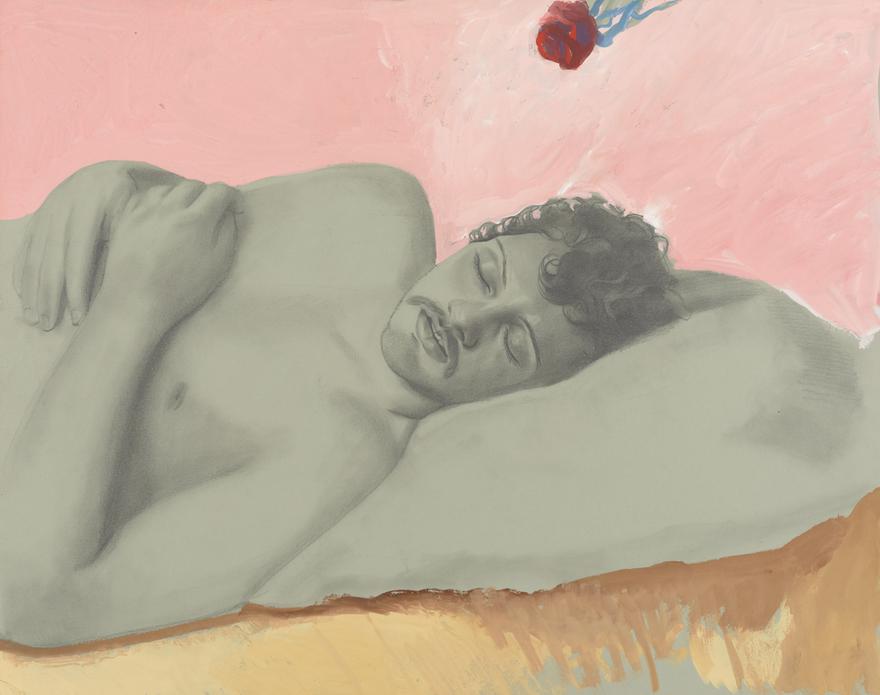
September 18 - October 24, 2020
Kapp Kapp, Philadelphia is pleased to present Gilbert Lewis: The Mind of Man, Portraits 1982 – 2009. This marks Lewis’ debut exhibition with Kapp Kapp and a unique moment of celebration for the artist in Philadelphia, where concurrent exhibitions are being presented at The Pennsylvania Academy of Fine Art, curated by Jodi Throckmorton; Woodmere Art Museum; and William Way LGBT Community Center.
The title of this exhibition of gouache and graphite works on paper by the artist Gilbert Lewis (b. 1945) is drawn from a line in Virginia Woolf’s Orlando that measures the effects of time on the human mind. Art is a record of the attempts made by humans over the centuries to bracket a direct experience of the natural passage of time, in addition to the built world, in so doing, inventing a cultural or “artificial” passage of time that exists first in the mind. In a mise-en-abyme fashion, the very cultural frames that once defined a historical view of a period, now relegated to the past, become the very stylistic frames through which to give expression to a sense of self that may run counter to a hegemonic order in space and time; take, for instance, a fluid notion of gender and sexuality inside of a social world that is shaped by a gender binary.
The portraits of queer young men coming of age that Gilbert painted in his Philadelphia studio apartment between the years of 1982 and 2009 are luminous palimpsests of the effects of time on the mind of the artist. They also mark a watershed in the cultural history of the United States when public views towards gay men in America had begun to shift at a more rapid pace in light of the outbreak of AIDS in the 1980s, and the global rise of neoliberalism in the 1990s. The queer personal history of each of his sitters is filtered through a history of art and a particular model of academic painting that is biographically attuned to the artist.
In 1963, Lewis moved to Philadelphia where he enrolled at the Pennsylvania Academy of Fine Arts. An avid draftsman, Lewis would sketch in museums across the city and eventually won a travel grant to Europe in the summer of 1967 alongside his peer Judy Pinto. Their trip followed in the wake of the Arno River, which had recently flooded Florence, damaging millions of manuscripts and works of art; nonetheless, Lewis managed to visit in person many of the Early Christian and Renaissance masterworks held by collections throughout Europe that would influence the classical bearing of his sitters. Those who typically sat for his portraits were two kinds of people: queer young men, as witnessed by Lewis, who is himself gay, and geriatrics—after Lewis earned a master’s degree in arts therapy in 1978 and began to work at a nursing home in Media, Pennsylvania.
A mainstay of the queer arts community in Philadelphia, Lewis would trade his artworks for his haircuts. On occasion, he invited the slender and bald-headed salesclerk who ran a vintage clothing store over to his studio where the clerk posed for a series of nude portraits in the early 1980s. Friends, friends of friends, and friends of friends who were boyfriends regularly sat for Lewis, and were encouraged by the artist to bring CDs or tapes of their favorite music to play during a session.
Despite a planar flatness, which cordons the sitter off in the space of his own interior world, there is a temporal depth to each portrait that is plumbable. Lewis took great care to paint in detail any identifying features of his sitters whether a tattoo, earring, shade of hair dye, or a personal item of clothing, which convey the private history of a stylistic decision made by the sitter in lieu of the artist. A temporal mashup of period styles inflects both our perception and reception of the interiority of his sitters. For instance, in Summer Portrait (2009), the regal poise of a young man in a sweater recalls the bearing of Albrecht Durer in a self-portrait that dates back to the year 1500. The manufactured stitch of the young man’s sweater and t-shirt returns us to the 21st century reality of sweatshops and shipping containers. What Lewis establishes through a stylized rendering of his sitters and their persona is a temporal gravitas and breadth of human consciousness not unlike the one Virginia Woolf writes for her queer protagonist Orlando, who is assigned a male gender at birth, only to become a woman over the course of a lifetime that spans centuries.
Lewis was drawn towards a state of interiority, both in terms of his art and therapy. Many have critiqued the notion of interiority, for reasons both pragmatic and philosophical. Nonetheless, the idea that a self is internally developed helps to counter the fraught sociocultural conditions of one’s own inherited place in time.
It seems that in the year 2020, in light of the social isolation mandated by a global pandemic and a collective reckoning with centuries of systemic abuse, entire systems and schools of thought have fallen by the wayside as people turn inwards. Now, it seems, and perhaps more than ever, the passage of time, as experienced by the mind, is a matter of life and death.
Gilbert Lewis (b. 1945, Hampton, VA) has exhibited at The Leslie-Lohmann Museum of Art, New York; The Montclair Art Museum, New Jersey; and the Pennsylvania Academy of Fine Art, Pennsylvania. Lewis is included in the collections of The Leslie-Lohmann Museum of Art, New York; Woodmere Art Museum, Pennsylvania; the Pennsylvania Academy of Fine Art, Pennsylvania; and the William Way LGBT Center, Pennsylvania.
Text by Desiree Mitton.